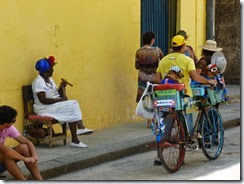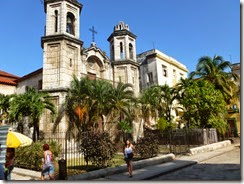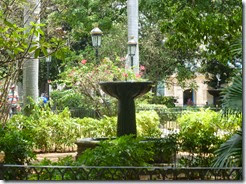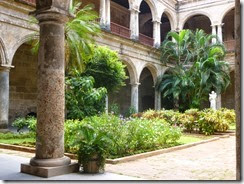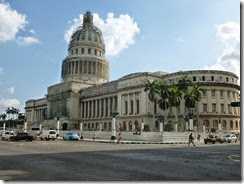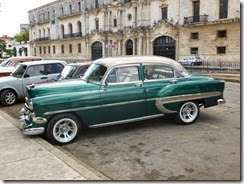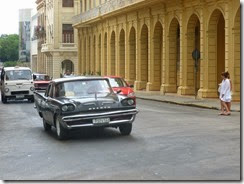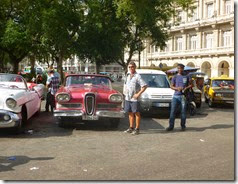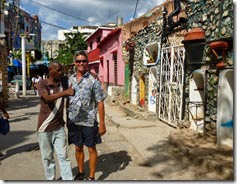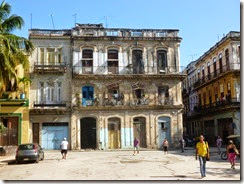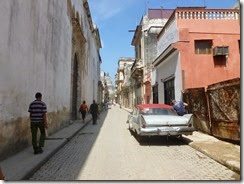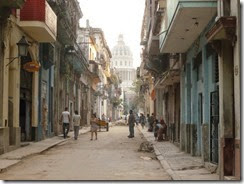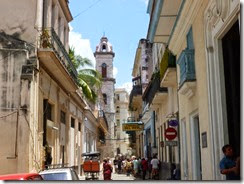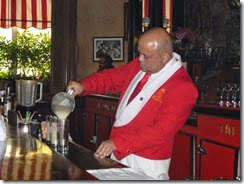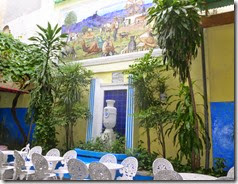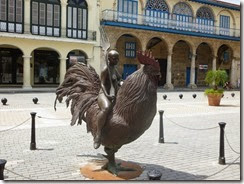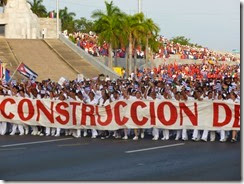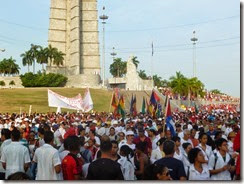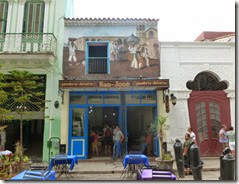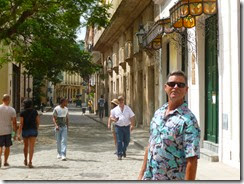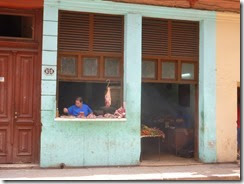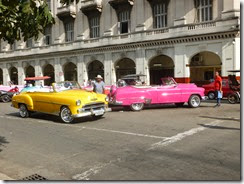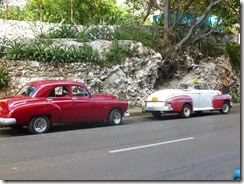No, I'm not paranoid, and no I do not think NSA is reading my e-mails (at least not all of them), but I did think twice about writing about our trip to Cuba this spring. At the moment Americans are only allowed to visit Cuba if they jump through some hoops related to getting permission to travel with journalistic, religious, and even "person to person" contact groups, but Americans still can't just up and visit Cuba even though citizens of every other country in the world can tour the Caribbean island. So when we reached Isla Mujeres in late April one of our decisions was whether would take advantage of the daily flights from Mexico to Cuba for a short visit to the "forbidden island". Being young and stupid we decided to go.
We had allowed only four days to visit Cuba so we decided to spend all of our time in the city of Havana on the north shore of what is a surprisingly large island. I can tell you that we loved everything about the trip. Havana is a lively, pleasant, well kept, tourist friendly city, and we were lucky enough to be there for this year’s massive May Day celebration. All of the Cubans that we met were outgoing and friendly and appeared to genuinely enjoy life. The city architecture had both modern high rises as well as some of the most beautiful colonial restorations that we have seen, and the suburbs of the city were clean and attractive.
And the cars... everywhere there were brightly painted old American cars. The importation of US cars ended abruptly after the 1959 revolution and thousands of cars from the ‘40s and ‘50s are still in use. These are beautiful classic cars being used as cabs and private transportation throughout Cuba. When I was in high school my sister and I had a 1961 Corvair Monza, the not so classic car that Ralph Nader wrote about using the catchy title "Death at Any Speed". When we caught a taxi to the Jose Marti airport in Havana at the end of our trip the cab was a 1960 Corvair. The body was perfect, but the engine had been converted to a diesel many years ago.
Many, many Cuban shops displayed a wide variety of art and handmade goods for sale and it was apparent that there is an abundance of artistic talent in Cuba. We saw bathtub art (yes, gaudily painted bathtubs), beautiful paintings, spray paint art, metal and wooden sculpture, leatherworks, etc. Even the aforementioned cars were a form of art painted in gaudy bright colors. Music (live and recorded) was everywhere and salsa bands and jazz combos played in many of the restaurants, parks, and public squares. The city had an entertaining and exciting vibration. Walking was in. We walked everywhere in the city exploring both the tourist zones and the residential and business areas, and we walked throughout Havana at all times of the day and night, in all kinds of neighborhoods, and never once felt threatened or uncomfortable.
We had arranged to stay in a "casa particular" during our visit rather than a hotel. The casas are private homes throughout the country that engage in a little capitalism (with government approval) by renting out rooms to visitors. Our casa was a narrow three story building in the middle of the city that had four bedrooms, three of which were available to tourists. The rooms were large and clean, and staying in a private home was another great way to meet Cubans. Note: When Castro took over in 1959 he first lowered all rents throughout Cuba and then he declared that all rental properties now belonged to the tenants. Revolutionary to say the least.
We discovered that two Cuban bars were the origin of some notable cocktails, the daiquiri at El Floridita and the mojito at El Bodeguita del Medio. (They also invented the Mary Pickford cocktail, but that didn't seem quite as impressive.) For a former bartender tracking down the "cradle of the daiquiri" or the "birthplace of the mojito" was akin to a religious pilgrimage so we spent several hours looking for the best of each cocktail in Havana. Ernest Hemingway is an iconic figure in Cuba and he apparently was present when all of these cocktails were invented, but I think he must have overpaid for his rum. If the bar claimed Hemingway drank there the rum usually cost twice as much as the bar next door.
We had a few favorite restaurants (Spanish Social Club, Art Pub) and bars that we visited several times. Many of the restaurants and hotels are run by the government tourist agency, and the employees are government employees, but we also found a number of privately owned establishments, a sign that capitalism was sometimes an attractive alternative to the state run businesses.
The highlight of our trip (at least on a par with the mojitos) was the May Day parade. This is the equivalent of our Labor Day, a huge celebration day in Europe and in many socialist countries honoring the workers of the world. In Cuba it has been an annual celebration of the socialist revolution long speeches and longer parades. We had hoped to hear Fidel Castro speak, but his health is failing and he did not appear at the celebration this year. The parade however was the largest we have ever seen or are likely to see again. We left our casa at 7 AM headed for Revolution Plaza. Along the way we saw scores of empty buses parked throughout the city that had been used to transport parade marchers to the plaza. As we neared the plaza we found a comfortable spot to watch the parade where we could also see the speakers platform. Masses of people filled the street near the podium waiting to march. But the entire parade covered only the one block in front of the platform. As soon as the marchers passed the reviewing stand they broke up and spread out. The parade was huge AND short. It was estimated that over 600,000 people marched in the parade, but the number of spectators was probably under 1,000. Everyone was a part of the march, participants not spectators, and the people we talked to were very proud to have been marching.
This is not to say that everything is perfect in Cuba. The Cuban economy is still struggling in the face of the American trade embargo and the collapse of the Russian state from which they had previously imported cheap oil and which provided markets for many Cuban goods. Rationing is still a fact of life in Cuba. Meat, milk, consumer goods, etc. are all rationed and are sometimes in short supply, and as in many major cities there are large areas of deteriorating buildings and apparent poverty (although both Andrea and I agreed that we have seldom felt safer in any city we have visited).
One of our first stops in the city was a barber shop where we both got quick cuts from a very talkative and friendly barber. He had many complaints about both Cuba and about Fidel, and we were surprised at how open he was with his criticism because we had thought that he would be more circumspect in the face of a socialist government. His major complaint after the state of the economy was that Cubans were not free to travel to other countries. In fact this was the most common complaint that we heard in Cuba. People were not particularly interested in leaving Cuba permanently, but almost everyone wanted to be able to visit other countries. They were also very excited to have visitors from the US.
Neither US dollars nor US credit cards can be used in Cuba so we needed to carry cash (Mexican pesos) for the trip. Cuba has two currencies in use: the Cuban peso (CUP), called "nationals", which are worth about a nickel and cannot be exchanged for other currencies, and the Cuban convertible peso (CUC) which is pegged to the dollar (go figure) and is exchangeable for Euros, Canadian dollars or Mexican pesos. Most of the shops selling food, milk, meat, vegetables, etc. accept the nationals while the tourist venues (bars, restaurants, hotels) only take the CUCs. Goods selling for nationals are heavily subsidized and are relatively inexpensive as we found out when we purchased a local beer for about $.40 (CUP) as opposed to the national beers that cost us about $2 (CUC). It also appeared that if you had CUCs you did not need the ration cards (La Libreta). Several times we were asked to buy milk or meat in the stores that required ration cards for Cubans but apparently not for tourists spending CUCs.
Cuba is so close to the US and it is a shame that we continue a 50 year old feud with one of our nearest neighbors. On the other hand the lack of American “culture” (fast food restaurants, chain stores, etc) is part of the charm of the island. The beautiful colonial buildings, the restorations throughout the city, the old cars, the distinct lack of internet and cell phones, the creative art scene and the omnipresent music all serve to make Cuba a very attractive travel destination.
Would we visit Cuba again? Anytime. Even with all of the traveling we have done over the last several years we have seldom had as much fun or visited a more interesting place than Havana. We will recommend Cuba to everyone, and we hope we get another opportunity visit “the forbidden island”.
Tom and Andrea
